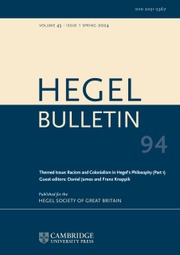Article contents
Hegel's Contradictions1
Published online by Cambridge University Press: 22 April 2013
Abstract
Perhaps one of the most difficult passages in Hegel's Science of Logic is his treatment of contradiction. If each moment of Hegel's logic is understood to constitute a sort of proof and since contradiction itself is presented as a moment of the logic, then in what sense can one comprehend a proof of contradiction as such? It is difficult to formulate this in any way that does not sound fundamentally incoherent, since it is not just at odds with our ordinary way of thinking but also with the overwhelming majority of the Western philosophical tradition. The basic problem, essentially, is this: if Hegel's logic includes contradiction as one of its moments, then how is Hegel's entire philosophical project not simply incoherent?
In the first part of this article, I will attempt to demonstrate one way in which Hegel's treatment of contradiction could in fact be considered coherent, through a close reading of the relevant passages. In this reading, I will particularly focus on the function of Hegel's dialectical concept of sublation (aufheben), and attempt to show (by example) how analysing Hegel's nuanced use of sublation can help us to work through some of his logic's complexities. The overall purpose here will be to present a systematic (as opposed to historical) exposition of Hegel's concept of contradiction and to illustrate the important role that this concept (as the contradiction of contradiction) plays in Hegel's logical method.
- Type
- Research Article
- Information
- Bulletin of the Hegel Society of Great Britain , Volume 32 , Special Issue 1-2: Special Issue on Kant and Hegel , 2011 , pp. 134 - 158
- Copyright
- Copyright © The Hegel Society of Great Britain 2011
Footnotes
Abbreviation:
SL: Hegel (1999).
HW: Hegel (1970); page numbers follow volume number.
References
- 2
- Cited by




